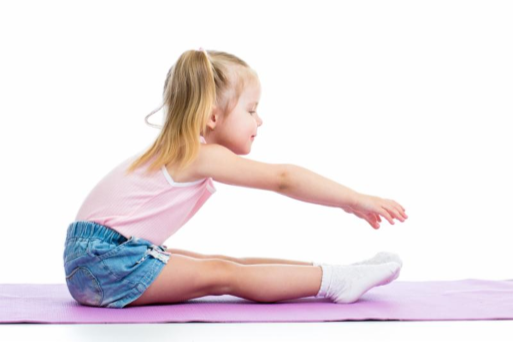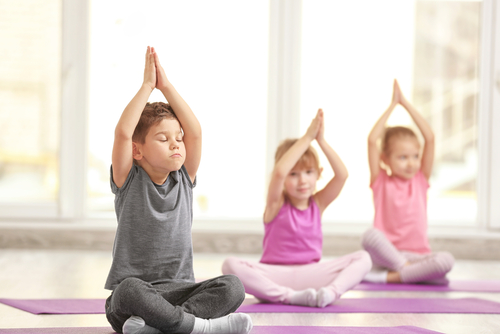Yoga and Meditation for Kids

Benefits of Yoga & Meditation for Children & Teens
There is scientific support for Yoga, Meditation and Mindfulness Practices with Children.
The following are some of the many research-based benefits of yoga, meditation, and mindfulness practices. These practices address the whole child, thus maximizing the development of academic, social and emotional competence:
- Provides students with healthy ways to express, balance, and regulate their emotions and behavior
- Promotes a more relaxed, comfortable state of being - the perfect state for teaching and learning
- Has a positive impact on students' academic performance
- Encourages community and connectedness within the classroom
- Eases anxiety and tension (such as pre-test or performance jitters)
- Reduces anger, depression, and fatigue
- Cultivates balanced psychological and physiological responses to stress, such as improved stress management
- Enhances focus, attention, concentration, comprehension and memory
- Provides opportunities for reflection, patience and insight, thereby reducing problem behaviors such as suspensions, bullying, unexcused absences, detentions, impulsivity, hostility, and reactivity.
- Supports social and emotional learning
- Enhances flexibility, strength, and physical well-being
- Improves mind/body awareness and self-awareness
- Enhances executive function (i.e., processes required to select, organize, and properly initiate goal-directed actions) by combining the cognitive and neurological benefits of physical activity with breathing exercises and mental focus techniques.
- Enhances resilience and coping frequency, thereby helping students adapt and cope with negative life events
- Improves confidence and self-esteem
- Encourages respect for oneself and others
- Improves physiological outcomes such as respiratory muscle strength

A number of studies in school settings also show improved attention and behavior. Some research has shown benefits for attention deficit hyperactivity disorder (ADHD), anxiety, depression, school performance, sleep, behavior problems, and eating disorders. For example, a trial of 300 low-income, minority urban middle-schoolers using school-based mindfulness instruction led to improved psychological functioning and lower levels of posttraumatic stress disorder (PTSD) symptoms.
There are also physical benefits as it calms the nervous system and decreases stress hormones. Studies have shown benefits for gastrointestinal symptoms, obesity, headaches, high blood pressure, pain sensitivity, and immune function. For example, a trial looking at the effect of mindful breathing meditation at a summer camp of 166 teens at risk for cardiovascular disease found that breathing awareness produced a reduction in blood pressure and heart rate.*
Yoga offers a non-competitive alternative to sports that supports PE and health standards, making it a beneficial after-school enrichment offering. Such programs can address stress and anxiety, place emphasis on individual abilities rather than competition, and provide a non-threatening and gentle method to increase physical fitness and enhance health, well-being and emotional resilience.
Research in this field is preliminary. However, scientific studies suggest that children who practice yoga-based movement, conscious breathing, and mindfulness/meditation activities are better able to regulate their emotions, manage stress and calm themselves. They may also choose better foods to eat and engage in more physical activity than children who do not. Studies also suggest that centered, calm and focused children learn more easily, have better social skills and, in general, are happier kids.
Studies also show that exercise facilitates children's executive functions (i.e., processes required to select, organize, and properly initiate goal-directed actions) by increasing activation in the prefrontal cortex. By integrating physical movement with breathing exercises and mindful awareness, yoga serves as a promising form of physical and cognitive training to enhance learning-related outcomes.
Yoga is fast becoming one of the most popular complementary health practices, with over 1.7 million children and teens practicing yoga-- a number that has grown by 400,000 in the last decade. Many schools are now offering movement and mindfulness programs to help reduce stress, improve mood, and promote physical fitness. Yoga during this formative period is useful for developing healthy exercise habits in general, as well as strength, flexibility, and balance.

The timing of yoga for teens is also particularly important for the mind, because the brain continues to develop throughout the early to late teenage years. The prefrontal cortex is the area behind the forehead and is known as the CEO of the brain for its ability to plan, organize, and regulate mood. The development of the prefrontal cortex gives you the ability to concentrate and think, rather than act on impulse, and is critical to being successful throughout the life stage, whether in academics, career, or relationships.
MRI studies have found that the first growth spurt of synapse formation in the prefrontal cortex occurs as a baby, and the second spurt of synapse formation occurs right before puberty, around age 11 in girls and 12 in boys. Learning is consolidated afterwards during adolescence through synaptic pruning, a weeding out process in which weak connections are plucked off and other connections are strengthened. Yoga during this time can help teens cultivate executive functions or the important skills of creativity, flexibility, self-control, and discipline.